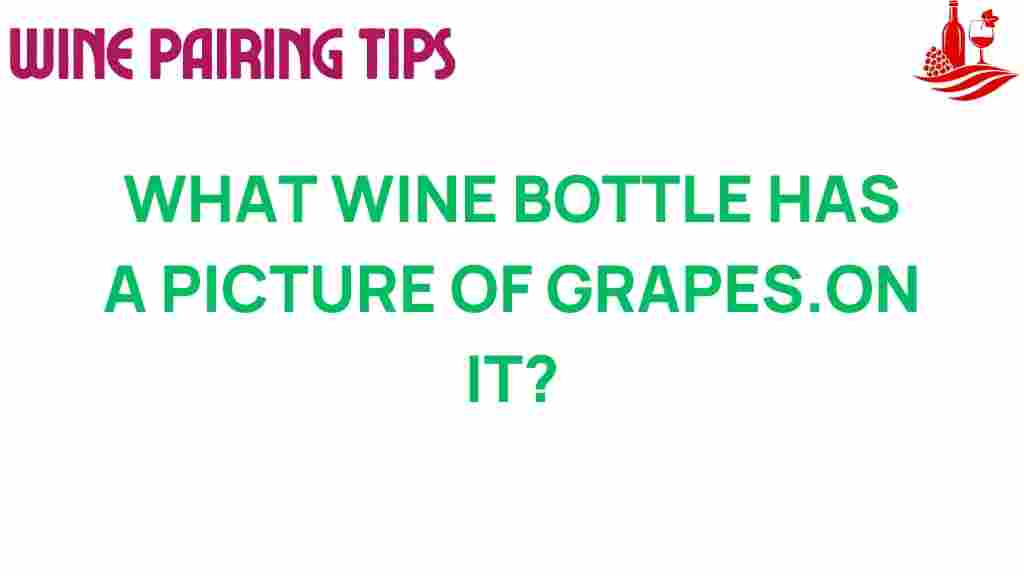Unveiling the Mystery: Which Wine Bottle Features Grapes?
When you stroll through the aisles of a wine shop or browse online for your next favorite bottle, the choices can be overwhelming. With countless wine bottles available, each adorned with unique label designs, one question often arises: which wine bottle features grapes? In this article, we will explore the significance of grapes in wine bottle design, how to identify wines through their labels, and some fascinating wine trivia that every wine enthusiast should know.
The Importance of Grapes in Wine
Grapes are the heart of wine production. The type of grape used in making a wine can significantly influence its flavor profile, aroma, and overall character. Understanding which grapes are used can help you appreciate the wine better. Here are some key points about grapes and their role in wine:
- Varietals: Each grape varietal has its unique taste and characteristics. Popular varietals include Cabernet Sauvignon, Chardonnay, Merlot, and Pinot Noir.
- Terroir: The local environment where grapes are grown affects their taste. Factors like soil, climate, and vineyard practices all play a crucial role.
- Vinification: The process of turning grapes into wine involves fermentation, aging, and bottling, which all impact the final product.
Understanding Wine Labels
The wine bottle label is not just decorative; it serves as a vital source of information for consumers. Here’s how to decode a wine label:
- Producer: The name of the winery or vineyard.
- Region: The geographic area where the grapes were grown. This can give clues about the wine’s flavor profile.
- Varietal: Indicates the type of grape used. Some labels may list multiple varietals.
- Vintage: The year the grapes were harvested, which can affect the wine’s taste and quality.
- Alcohol Content: Usually expressed as a percentage, this indicates the strength of the wine.
When it comes to wine identification, familiarizing yourself with these elements can enhance your tasting experience and help you choose the right bottle for any occasion.
Label Design and Bottle Art
The label design of a wine bottle often reflects the winery’s identity and the essence of the wine itself. Creative bottle art can attract buyers and convey the style of the wine. Here are some notable trends in wine label design:
- Minimalism: Simple designs with bold typography are becoming increasingly popular.
- Illustrative Art: Many wineries opt for detailed illustrations, often depicting the vineyard or local scenery.
- Eco-Friendly Labels: Sustainable practices are reflected in the use of recycled materials and biodegradable inks.
As a wine enthusiast, you’ll often find that a captivating label can draw you in, but it’s essential to look beyond aesthetics to understand the quality of the wine within.
Wine Trivia: Fun Facts About Grapes and Wine
- The world’s oldest known wine cellar was discovered in Armenia, dating back over 6,000 years.
- There are over 10,000 grape varietals cultivated worldwide.
- The heaviest grape cluster on record weighed over 5 kg (11 lbs).
- Wine can improve with age, but not all wines are meant to be aged. Most wines are best enjoyed within a few years of bottling.
These fun facts can serve as great conversation starters at your next wine tasting or gathering with fellow wine enthusiasts.
Step-by-Step Process of Choosing the Right Wine Bottle
Now that we’ve delved into the elements of wine and its fascinating culture, let’s look at a step-by-step process for selecting the perfect wine bottle:
- Identify Your Preferences: Consider what flavors you enjoy. Do you prefer red, white, or rosé? Are you a fan of sweet or dry wines?
- Research Regions: Familiarize yourself with wine regions known for specific varietals. For example, Bordeaux is famous for Cabernet Sauvignon and Merlot.
- Examine the Label: Look for the varietal, region, and vintage. This information can greatly influence your choice.
- Read Tasting Notes: Check for tasting notes either on the bottle or online to understand the flavor profile.
- Seek Recommendations: Don’t hesitate to ask staff at wine shops for their recommendations based on your preferences.
- Consider Food Pairing: Think about what you’ll be serving. Certain wines pair better with specific dishes.
By following these steps, you can confidently choose a wine bottle that will enhance your experience and delight your palate.
Troubleshooting Tips for Wine Selection
Even with the best intentions, you may sometimes find yourself with a wine bottle that doesn’t meet your expectations. Here are some troubleshooting tips:
- Too Sweet: If you find a wine too sweet, consider pairing it with savory foods to balance the flavors.
- Too Tannic: If a red wine feels too tannic, try decanting it for a few hours before drinking to soften the tannins.
- Off Flavors: If you encounter an unpleasant taste, it may be due to improper storage. Ensure your wines are stored in a cool, dark place.
- Price vs. Quality: Remember that a higher price doesn’t always guarantee better quality. Explore different price ranges and find wines that suit your palate.
With these tips, you can navigate the world of wine more effectively and enjoy your selections to the fullest.
Conclusion
In conclusion, understanding the elements surrounding wine bottles and grapes can significantly enhance your wine-tasting experience. From decoding label designs to exploring intriguing wine trivia, there’s a wealth of knowledge to uncover. Whether you are a casual drinker or a passionate wine enthusiast, delving into the world of wine can be a rewarding journey. So next time you pick a bottle, remember the grapes behind the label, and enjoy the rich tapestry of flavors that each wine offers.
For further reading on wine culture and tips for enthusiasts, check out this informative resource. And if you’re looking to expand your collection or learn more about specific wines, visit this wine guide for comprehensive insights and recommendations.
This article is in the category Tasting and created by Wine Pairing Tips Team
